Colorado is a state of majestic beauty, from the peaks of the Rocky Mountains to the grasses of the Great Plains. It’s home to a wide variety of animals such as moose and mountain lions. The state is also the home of many species of spiders. The spiders in Colorado come in all shapes and sizes, from tiny jumping spiders to giant wolf spiders. Here is a list of 10 spiders in Colorado that you may encounter if you spend time in The Centennial State.
#10: Hobo Spider

The hobo spider is often confused with the wolf spider due to its similar appearance.
©SNEHIT PHOTO/Shutterstock.com
The hobo spider is a member of the funnel web spider family Agelenidae. You can find hobo spiders in Colorado as well as throughout western North America, Europe, and Central Asia. It gets its name from its presumed method of spreading its distribution by hitching a ride in cars throughout the Pacific Northwest.
Hobo spiders measure between 7 and 14 millimeters long, with females measuring larger than males. It’s mostly a uniform brownish color and is usually distinguishable by the v-shaped markings running down its carapace pointing toward its head.
The hobo spider builds a funnel-shaped web and then lies in wait at one end to wait for prey to wander into its trap. Despite some rumors about the bite of a hobo spider being dangerously venomous, no good evidence exists to support this claim. In all likelihood, its bite will cause little more than some pain, redness, and swelling.
#9: Contrasting Jumping Spider
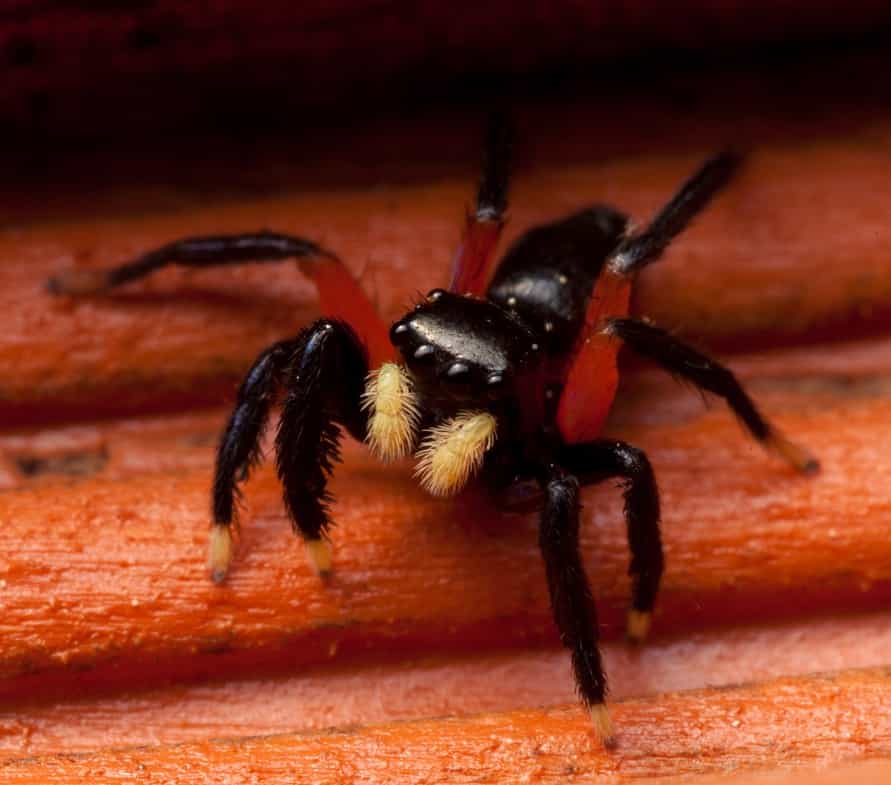
A contrasting jumping spider does not build a web but relies on its keen eyes and agility to catch its prey.
©Marc Dufour/CC BY-SA 3.0 – License
First described in 1891, Euophrys monadnock also goes by the common name the contrasting jumping spider. It is a member of the family Salticidae, or jumping spiders. While you can find these spiders in Colorado they are also distributed throughout the western United States and Canada.
A small species, most contrasting jumping spiders measure less than 10 millimeters long, with males measuring smaller than females. They get their name from their contrasting black and orange coloration, with the hind legs being black on the bottom half and orange on the top half. Meanwhile, the rest of their body is black and possesses a glossy sheen.
Like other jumping spiders, the contrasting jumping spider does not build a web. Instead, it relies on its keen eyes and agility to catch its prey. Due to its small size, its bite is not considered a threat to humans.
#8: Bridge Orb Weaver

The web of a bridge orb weaver can measure over 2 feet wide.
©Paul Reeves Photography/Shutterstock.com
The bridge orb weaver belongs to the orb weaver family Araneidae. It also goes by the name the gray cross spider or the gray cross orb weaver. You can find these spiders in Colorado as well as throughout the central and eastern United States and parts of Europe.
Female bridge orb weavers measure between 10 and 14 millimeters long, while males measure 8 to 9 millimeters in length. Most specimens are predominantly grey and feature tan and white bands on their legs. They also feature dark markings on the abdomen.
It gets its name from its habit of building webs on steel structures such as bridges. Its web can measure over 2 feet wide and the spider will remain in its center as it waits for prey. The average bridge orb weaver will only bite when its web is threatened and its bite is not considered dangerous to humans.
#7: Striped Fishing Spider
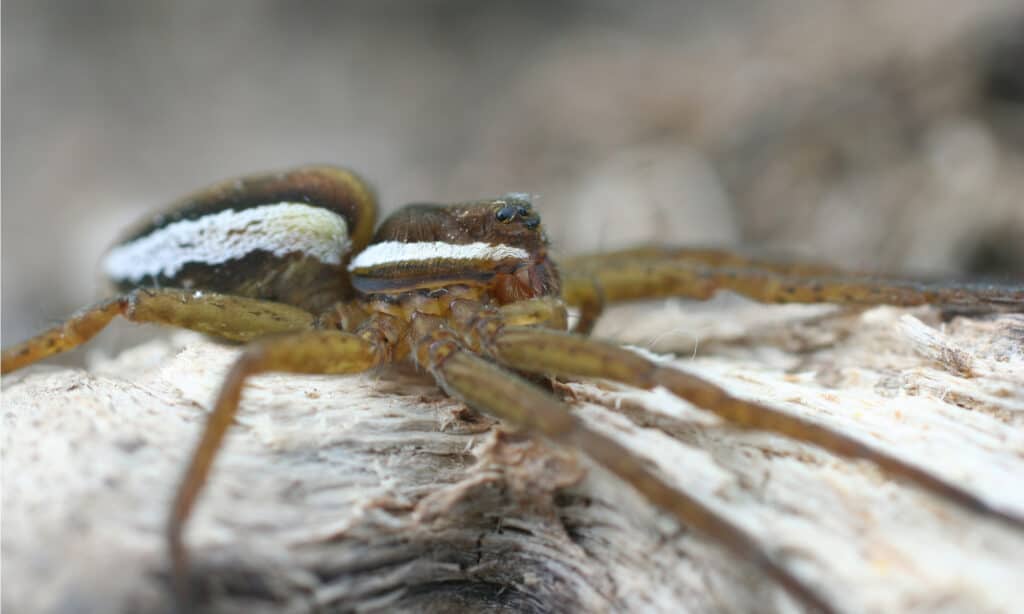
The striped fishing spider hunts by kneeling on its hind legs with its forelegs stretched over the water’s surface ready to snatch prey.
©Oleg Nikonov/Shutterstock.com
The striped fishing spider is a member of the fishing spider family Pisauridae. You’re most likely to find these spiders near streams or ponds, which is where they hunt for their prey.
Females can reach up to 2.5 centimeters long, while males measure smaller than females. Their color is predominantly greyish-brown and some specimens feature a white or tan stripe down each side of the body. They also feature w-shaped marks on the abdomen.
The striped fishing spider hunts by kneeling on its hind legs with its forelegs stretched over the water’s surface ready to snatch prey. When necessary, it can also dive under the water or dart across its surface to catch insects. It’s one of the only spiders in Colorado that hunts for small vertebrates such as small fish. Despite its large size, its bite is not considered a threat to humans.
#6: Banded Garden Spider

The banded garden spider’s web typically measures around 2 feet wide.
©Protasov AN/Shutterstock.com
The banded garden spider is a member of the orb weaver family Araneidae. Once native to North and South America, it is now found throughout much of the world. It’s commonly found outside, as it normally spins its web between plants in gardens and fields.
Female banded garden spiders measure between 15 and 25 millimeters long, with males measuring 4 to 5 millimeters in length. They get their name from the alternating black and yellowish-silver bands that run along their abdomens.
The banded garden spider’s web typically measures around 2 feet wide but can be wider depending on the size of the spider and the web’s location. Females will rest in the center of the web hanging upside down and wait for prey to stumble into the silk strands. Its bite is not considered medically significant and poses little threat to humans.
#5: Redlined Wolf Spider
The redlined wolf spider is a species of wolf spider in the family Lycosidae. You can find redlined wolf spiders throughout Colorado as well as in several other surrounding states and Canada.
Redlined wolf spiders can reach up to 2 centimeters in length, with females measuring larger than males. They appear primarily reddish-brown and sport a glossy carapace and legs, which is where they get their name. Meanwhile, their abdomen is tan and features grey or black markings.
Like other wolf spiders, the redlined wolf spider is an aggressive hunter that does not rely on a web to catch prey. Instead, it relies on its keen eyesight, speed, and power to subdue insects. As its bite is not poisonous, it doesn’t pose a threat to humans, but its bite can still be quite painful due to its large jaws.
#4. Hentz’s Orb Weaver
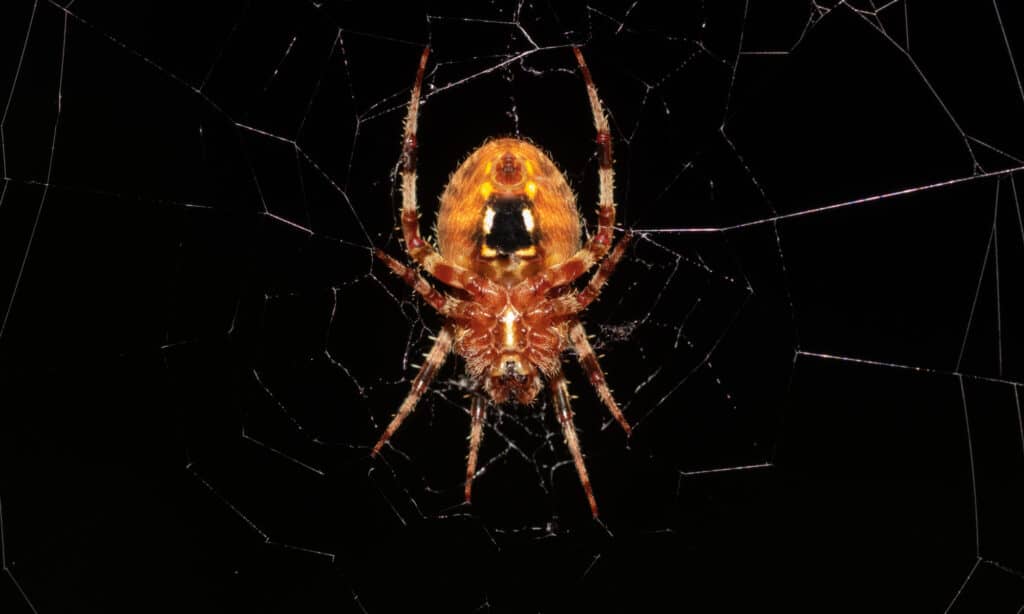
Hentz’s orb weavers build large, wagon-shaped webs and mostly hunt at night.
©Christopher Troll/Shutterstock.com
Another member of the Aranaidae family to make our list of spiders in Colorado is Hentz’s orb weaver. Also known as the spotted orb weaver, Hentz’s orb weaver is a common sight throughout much of the United States. It’s mostly found outdoors, which is where it constructs its webs.
Hentz’s orb weavers are quite large and females measure anywhere from 12 to 18 millimeters long. Meanwhile, males are significantly smaller, barely reaching half the length of the females. As their other common name implies, Hentz’s orb weavers feature two distinct white spots under their abdomens.
They build large, wagon-shaped webs that they use to catch their prey. They mostly hunt at night and hide during the day, but mature females have been known to stay in their webs during the daytime. Hentz’s orb weavers are not particularly venomous and do not often bite people, so are not considered dangerous.
#3. Barn Funnel Weaver
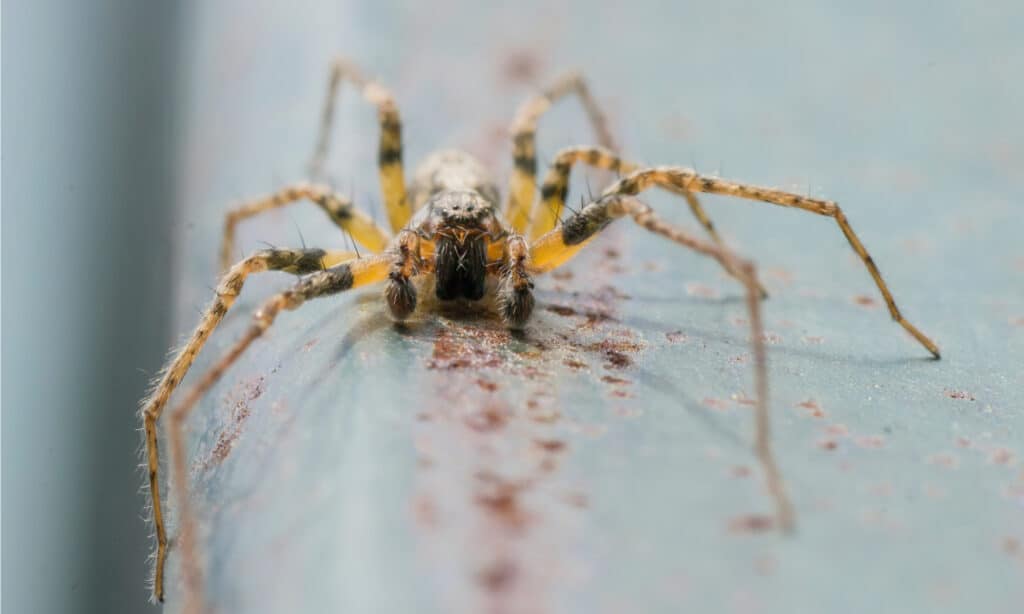
The barn funnel weaver builds a funnel-shaped web to catch its prey and is a skilled hunter.
©Korovko Gleb/Shutterstock.com
Tegenaria domestica, or the barn funnel weaver, is a member of the funnel-web family Agelenidea. While you can find these spiders in Colorado it is also a common sight in Africa, Asia, and Europe, where they go by the name domestic house spider.
Barn funnel weavers possess long bodies and a more straight than the bulbous abdomen. They are predominantly light brown in color, although their abdomens are gray-brown and feature a dark stripe down the middle. Females typically measure 7 to 11 millimeters long, with males measuring from 6 to 9 millimeters in length.
As its name implies, the barn funnel weaver builds a funnel-shaped web to catch its prey. It is a skilled hunter and quickly responds to vibrations in its web to subdue its victims. Due to its size, a bite from a barn funnel weaver is unlikely to break human skin.
#2: Oblong Running Spider
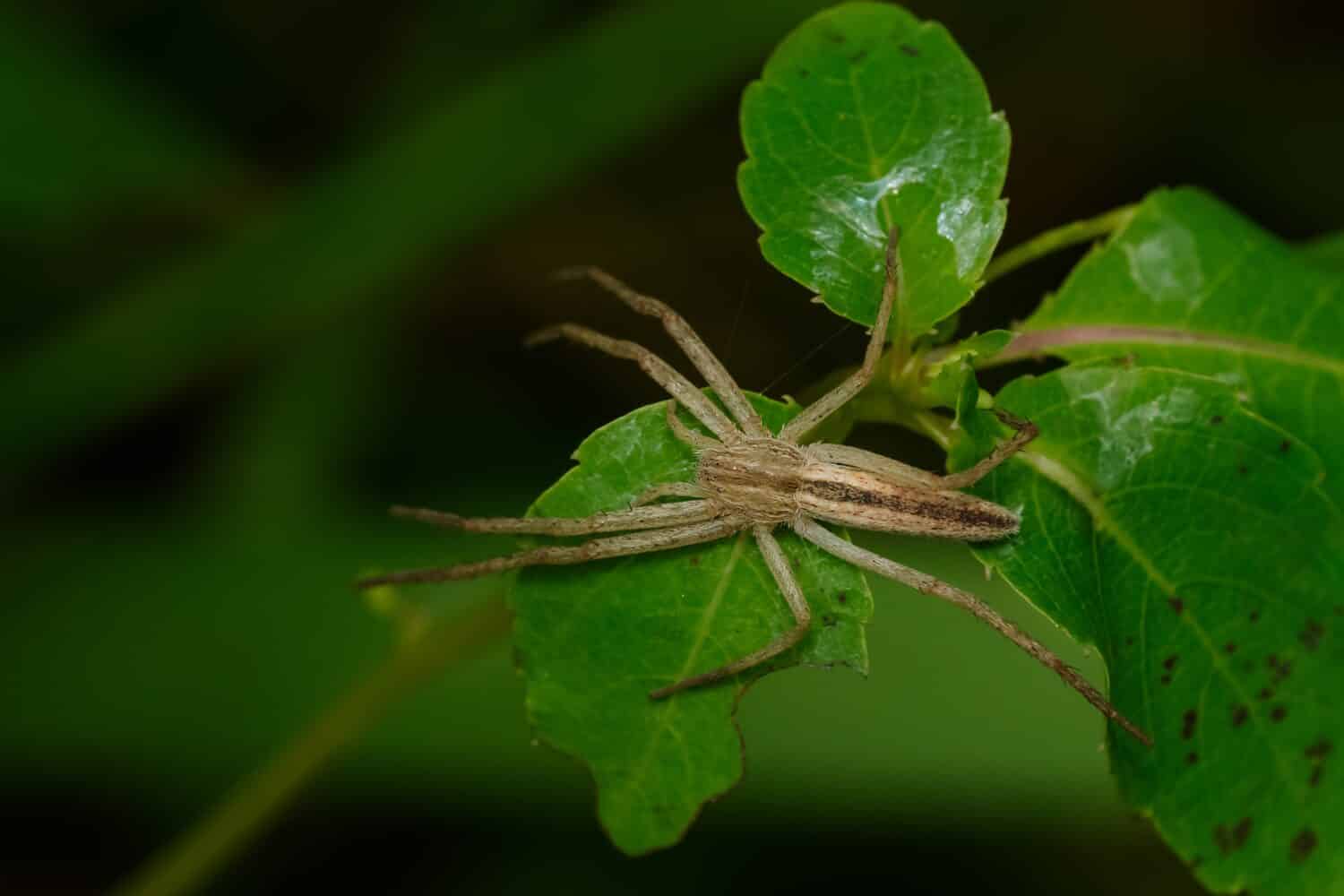
Oblong running spiders do not spin webs to hunt and instead rely on their speed to catch prey.
©Paul Reeves Photography/Shutterstock.com
The oblong running spider is a member of the running spider family Philodromidae. It is part of the genus Tibellus, or the slender crab spiders, of which it is the most common member. You can find these spiders in Colorado as well as throughout the United States, Europe, and Asia.
Female oblong running spiders measure 6 to 9.5 millimeters long, while males measure slightly smaller. Their bodies and legs are predominantly light or reddish-brown. Their abdomens are quite long and cylindrical, which is where they get their name, and mostly cream in color with a dark brown stripe down the middle.
Oblong running spiders do not spin webs to hunt and instead rely on their speed to catch prey. They are quick and also stealthy and use ambush tactics to subdue their targets. Generally, their bite is not considered dangerous to humans, although it can be quite painful.
#1. Apache Jumping Spider
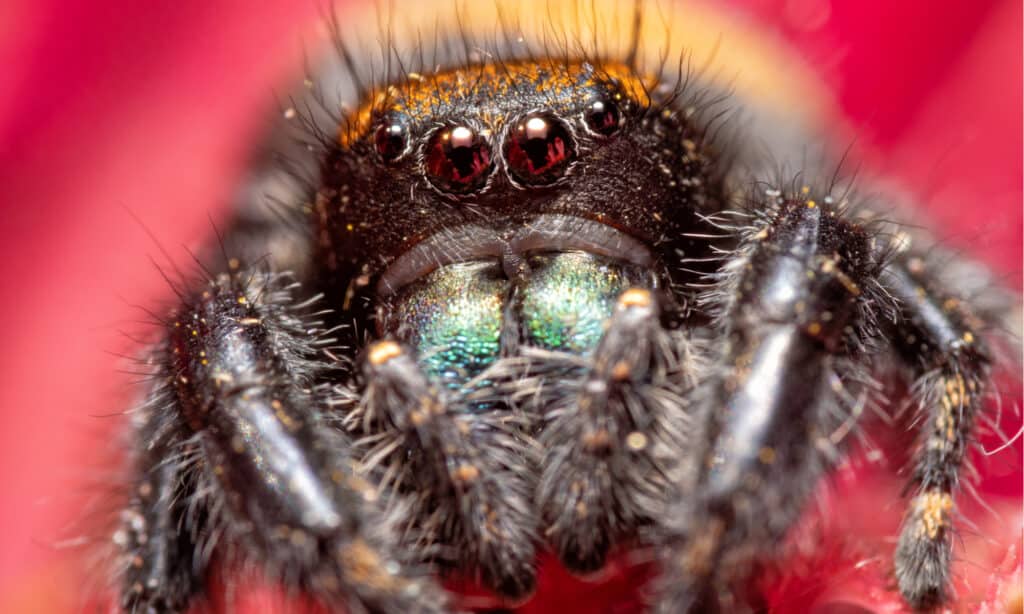
The Apache jumping spider gets its name from its bright coloring.
©Sari ONeal/Shutterstock.com
The Apache jumping spider is a large species in the jumping spider family Salticidae. You can find these spiders in Colorado as well as throughout the central and southern United States. It gets its name from the Apache tribe thanks to its bold colors.
Apache jumping spiders are predominantly black with orange hairs on the top of the cephalothorax and abdomens that often feature a dark median stripe. Additionally, they sport large, iridescent green mouthparts. Female Apache jumping spiders are quite large, capable of reaching nearly 22 millimeters long. On the other hand, males are much smaller, with some no more than 3 millimeters in length.
Apache jumping spiders are active hunters that rely on their speed and eyesight rather than webs to catch prey. While small specimens can not break human skin, larger females can, although their bite is not considered threatening.
Summary of 10 Spiders in Colorado
| Index | Species | Key Features | Range |
|---|---|---|---|
| 10 | Hobo Spider | Uniform brownish color V-shaped markings along the carapace pointing toward the head | Throughout western North America, Europe, and Central Asia. |
| 9 | Contrasting Jumping Spider | Black body with a glossy sheen Hind legs which are a contrasting black and orange | Throughout the western United States and Canada. |
| 8 | Bridge Orb Weaver | Gray coloration with tan and white bands on the legs Dark markings on the abdomen | Throughout the central and eastern United States and parts of Europe |
| 7 | Striped Fishing Spider | Grayish-brown bodies and occasionally a white or tan stripe along each side W-shaped marks on the abdomen | The United States and Canada |
| 6 | Banded Garden Spider | Alternating black and yellow, and silver bands along the abdomen | In most countries all over the world |
| 5 | Redlined Wolf Spider | Reddish-brown with a glossy carapace and legs Tan abdomen with gray or black markings | Colorado, neighboring states, and Canada |
| 4 | Hentz’s Orb Weaver | Two distinct white spots under their abdomens | Throughout much of the United States. |
| 3 | Barn Funnel Weaver | Narrow gray-brown abdomens with a dark stripe at the center | Also found in Africa, Asia, and Europe |
| 2 | Oblong Running Spider | Narrow cream-colored abdomen with a darker stripe running down the center | Throughout the United States, Europe, and Asia. |
| 1 | Apache Jumping Spider | Black cephalothorax covered in orange fuzz Bright green mouthparts (chelicerae) | Throughout the central and southern United States |
The photo featured at the top of this post is © Sari ONeal/Shutterstock.com
Thank you for reading! Have some feedback for us? Contact the AZ Animals editorial team.






